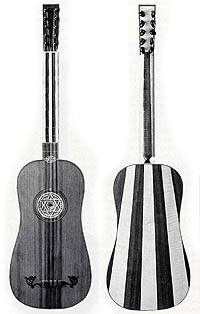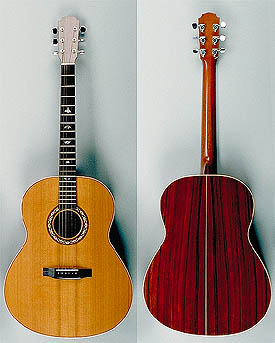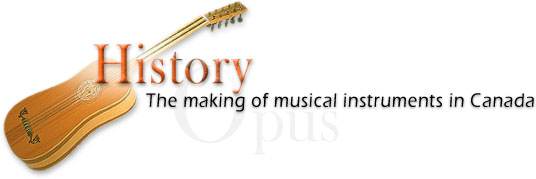|
|
 |
 his
guitar is based on a traditional model; the decorative alternating strips
on the back of the instrument probably date it to the early eighteenth century.
The Arab-style rose consists of seven superimposed layers of finely cut-out
parchment. Carved on a piece of ivory at the base of the neck is the inscription
"M. Dunn R. Nurse 1971." his
guitar is based on a traditional model; the decorative alternating strips
on the back of the instrument probably date it to the early eighteenth century.
The Arab-style rose consists of seven superimposed layers of finely cut-out
parchment. Carved on a piece of ivory at the base of the neck is the inscription
"M. Dunn R. Nurse 1971."
| |

Baroque Guitar
By
Michael Dunn and Ray Nurse
Vancouver, British Columbia
1973
Spruce, mansonia, maple, parchment,
ebony, gut, nylon
Overall length: 93.5 cm;
body: 44.5 x 24.5 cm;
sides: 8 cm
|
Opus 25 and 26
Steel-String Guitars
These steel-string
folk guitars are designed to accompany singing. The fourteen-fret neck appeared
in the late 1920s to facilitate the transition from the banjo to the guitar
for musicians who played both instruments. Metal-string guitars have existed
since the seventeenth century. The modern six-string guitar dates from the
mid-nineteenth century, when the famous C.F. Martin company began manufacturing
it in the United States.
The instruments shown here represent William Laskin's début as a
professional luthier in the 1970s.
| |

Steel-String Guitar
By
William Laskin
Toronto, Ontario
1973
Rosewood, cedar, Canadian maple, spruce, abalone, holly, Honduran mahogany,
metal, ivory, ebony, steel
Overall length: 103.5 cm;
body: 50 x 40 cm;
sides: 10.5 cm
Label: "William Laskin luthier Toronto 73".
They are signed "Grit Laskin."
|
William Laskin
http://www.williamlaskin.com

 Video Excerpt
Video Excerpt
William Laskin
Toronto, Ontario
1991
William Laskin is an accomplished luthier as well as a guitarist and composer. His
numerous activities attest to his great interest in all facets of the luthier's
craft. He has organized two major exhibitions on instrument making and has
given several talks and demonstration workshops. He is the author of
The World of Musical Instrument Makers: A Guided Tour, which focuses on
instrument makers in the Toronto area, and he is the director of the Associated String
Instrument Artisans. In 1971, at the age of eighteen, he met luthier Jean-Claude
Larrivée, who agreed to take him on as an apprentice in his workshop.
Laskin gave his undivided attention to this new passion and opened his own
workshop two years later. To date, he has made over 450 instruments, including
acoustic, classical and flamenco guitars, and instruments of the mandolin
family. Many of his instruments belong to renowned musicians. William Laskin
is also noted for the marquetry and elaborate inlays that adorn his guitars.
| |
 William Laskin's label
William Laskin's label
|
|







